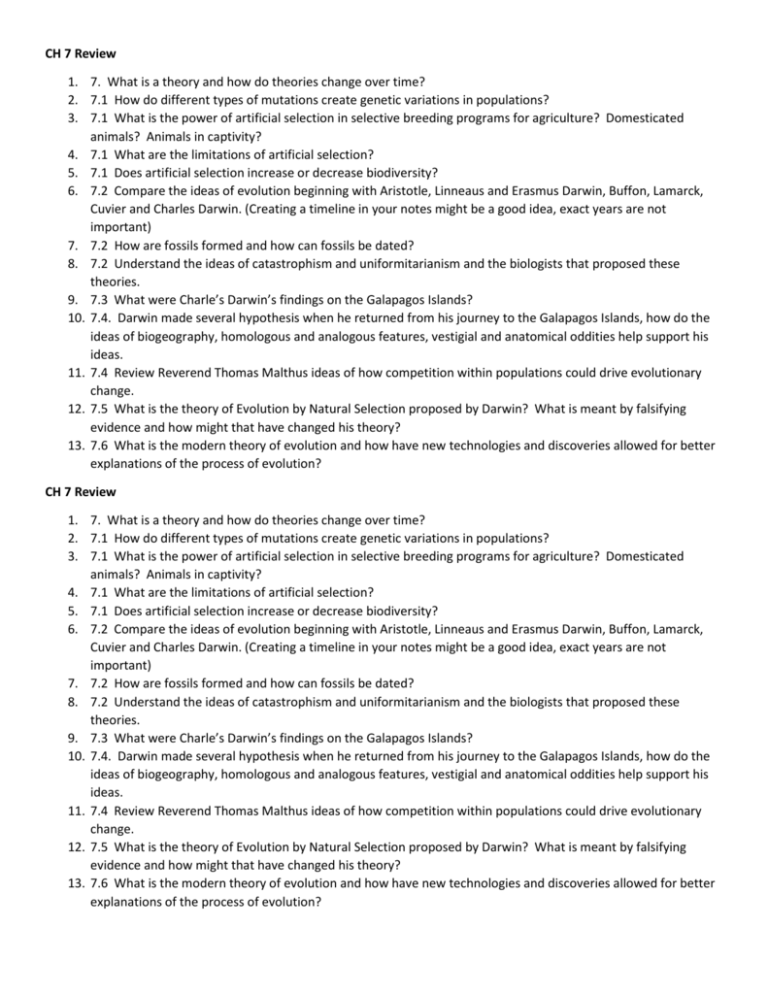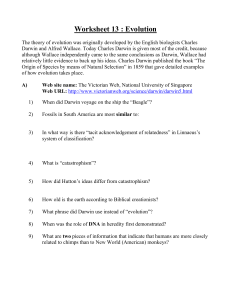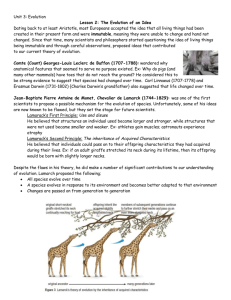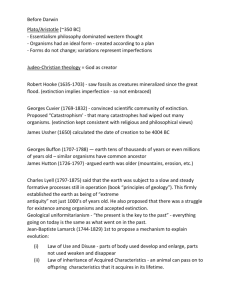Chapter 7 Test Review
advertisement

CH 7 Review 1. 7. What is a theory and how do theories change over time? 2. 7.1 How do different types of mutations create genetic variations in populations? 3. 7.1 What is the power of artificial selection in selective breeding programs for agriculture? Domesticated animals? Animals in captivity? 4. 7.1 What are the limitations of artificial selection? 5. 7.1 Does artificial selection increase or decrease biodiversity? 6. 7.2 Compare the ideas of evolution beginning with Aristotle, Linneaus and Erasmus Darwin, Buffon, Lamarck, Cuvier and Charles Darwin. (Creating a timeline in your notes might be a good idea, exact years are not important) 7. 7.2 How are fossils formed and how can fossils be dated? 8. 7.2 Understand the ideas of catastrophism and uniformitarianism and the biologists that proposed these theories. 9. 7.3 What were Charle’s Darwin’s findings on the Galapagos Islands? 10. 7.4. Darwin made several hypothesis when he returned from his journey to the Galapagos Islands, how do the ideas of biogeography, homologous and analogous features, vestigial and anatomical oddities help support his ideas. 11. 7.4 Review Reverend Thomas Malthus ideas of how competition within populations could drive evolutionary change. 12. 7.5 What is the theory of Evolution by Natural Selection proposed by Darwin? What is meant by falsifying evidence and how might that have changed his theory? 13. 7.6 What is the modern theory of evolution and how have new technologies and discoveries allowed for better explanations of the process of evolution? CH 7 Review 1. 7. What is a theory and how do theories change over time? 2. 7.1 How do different types of mutations create genetic variations in populations? 3. 7.1 What is the power of artificial selection in selective breeding programs for agriculture? Domesticated animals? Animals in captivity? 4. 7.1 What are the limitations of artificial selection? 5. 7.1 Does artificial selection increase or decrease biodiversity? 6. 7.2 Compare the ideas of evolution beginning with Aristotle, Linneaus and Erasmus Darwin, Buffon, Lamarck, Cuvier and Charles Darwin. (Creating a timeline in your notes might be a good idea, exact years are not important) 7. 7.2 How are fossils formed and how can fossils be dated? 8. 7.2 Understand the ideas of catastrophism and uniformitarianism and the biologists that proposed these theories. 9. 7.3 What were Charle’s Darwin’s findings on the Galapagos Islands? 10. 7.4. Darwin made several hypothesis when he returned from his journey to the Galapagos Islands, how do the ideas of biogeography, homologous and analogous features, vestigial and anatomical oddities help support his ideas. 11. 7.4 Review Reverend Thomas Malthus ideas of how competition within populations could drive evolutionary change. 12. 7.5 What is the theory of Evolution by Natural Selection proposed by Darwin? What is meant by falsifying evidence and how might that have changed his theory? 13. 7.6 What is the modern theory of evolution and how have new technologies and discoveries allowed for better explanations of the process of evolution?











